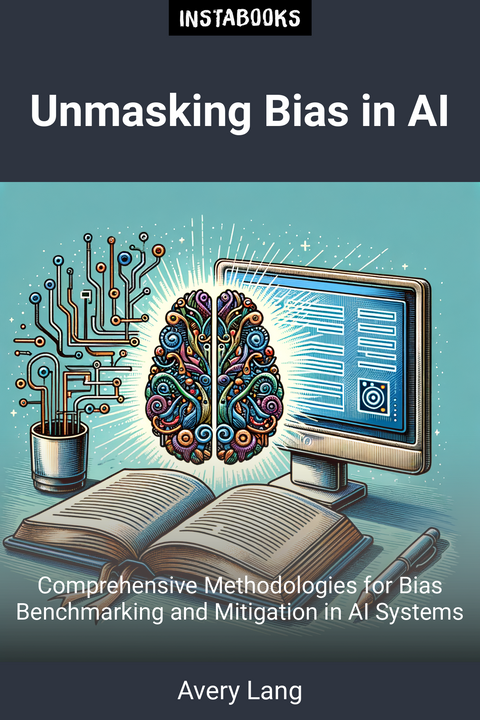
Unmasking Bias in AI
Comprehensive Methodologies for Bias Benchmarking and Mitigation in AI Systems
Included:
✓ 200+ Page AI-Generated Book
✓ ePub eBook File — read on Kindle & Apple Books
✓ PDF Print File (Easy Printing)
✓ Word DOCX File (Easy Editing)
✓ Hi-Res Print-Ready Book Cover (No Logo Watermark)
✓ Full Commercial Use Rights — keep 100% of royalties
✓ Publish under your own Author Name
✓ Sell on Amazon KDP, IngramSpark, Lulu, Blurb & Gumroad to millions of readers worldwide
Introduction
In the rapidly evolving world of artificial intelligence, the challenge of bias in large language models (LLMs) has emerged as a critical issue. "Unmasking Bias in AI" dives deep into the methodologies and strategies that can be employed to ensure fairness and equity in AI systems. This book is not just a theoretical exploration but a practical guide rooted in the groundbreaking SAGED pipeline, developed for effective bias evaluation in LLMs.
The Challenge of Bias in AI
Current benchmarks for language models often fall short, struggling to detect biases due to their limited scope and vulnerability to contamination. Through comprehensive research and case studies, this book sheds light on how bias manifests in LLMs and the urgent need for robust evaluation criteria.
The SAGED Pipeline
At the heart of the book lies the SAGED pipeline, an innovative framework comprising five essential stages. Readers will learn how to:
- Scrape Materials: Gather relevant and diverse data.
- Assemble Benchmarks: Create effective evaluation criteria tailored for bias detection.
- Generate Responses: Harness LLMs for producing insightful outputs.
- Extract Numeric Features: Identify and analyze numerical metrics that signify bias.
- Diagnose with Disparity Metrics: Use advanced metrics to evaluate and diagnose biases.
Bias Metrics and Mitigation Techniques
Understanding how to measure bias is crucial for any AI practitioner. The book introduces key metrics such as max disparity and bias concentration. Moreover, readers will uncover innovative techniques to mitigate distortions from biases, including:
- Counterfactual Branching: A method for assessing various outcomes.
- Baseline Calibration: Adjusting for tool biases to ensure fair evaluations.
Case Studies: Learning from the Best
In-depth case studies of models like Mistral and Qwen2 reveal differentiated biases across contexts and use cases. By examining role-playing scenarios with public figures such as U.S. presidents, readers will gain unique insights into how model behavior can be influenced and skewed by biases. These real-world examples highlight the importance of a nuanced understanding of LLM behavior.
A Holistic Approach to AI Fairness
This book emphasizes the necessity of a holistic approach to bias evaluation. By integrating comprehensive methodologies from material scraping to diagnostic metrics, readers will be well-equipped to navigate the complexities of bias in language models. The final chapters discuss future directions and the overarching goal of creating fair and equitable AI systems that serve all communities equally.
Table of Contents
1. Understanding Bias in Language Models- The Origins of Bias
- Impact on AI Systems
- Consequences of Bias in Society
2. Introduction to the SAGED Pipeline
- Overview of SAGED
- Importance of Customization
- Five Key Stages Explained
3. Material Scraping Techniques
- Identifying Relevant Data Sources
- Methods for Scraping Materials
- Ensuring Data Diversity
4. Creating Effective Benchmarks
- Assembling Evaluation Criteria
- Key Considerations for Benchmark Design
- Testing and Refining Benchmarks
5. Response Generation in LLMs
- Techniques for Generating Outputs
- Evaluating Model Responses
- Addressing Response Quality
6. Extracting and Analyzing Numeric Features
- Key Metrics for Bias Assessment
- Numeric Feature Extraction Techniques
- Analyzing Results for Insights
7. Understanding Bias Metrics
- Max Disparity Explained
- Bias Concentration Metrics
- Counterfactual Analysis
8. Mitigation Techniques for Bias
- Counterfactual Branching Approaches
- Baseline Calibration Strategies
- Practical Steps for Bias Mitigation
9. Case Studies of Mistral and Qwen2
- Observing Bias in Action
- Analyzing Role-Playing Scenarios
- Comparative Analysis of Model Behaviors
10. Holistic Approaches to AI Fairness
- Integrating Methodologies for Evaluation
- Community Considerations in AI
- Future Directions for Fair AI
11. Tools for Implementing Fairness in AI
- Software Solutions for Benchmarking
- Data Collection Tools
- Networks and Collaborations for Fair AI
12. The Future of Unbiased Language Models
- Trends in AI Development
- Ethical Considerations for AI Practitioners
- Building a Fairer AI Landscape
Target Audience
This book is written for AI researchers, machine learning practitioners, and ethicists who want to deepen their understanding of bias in large language models and a comprehensive methodology for fairer AI systems.
Key Takeaways
- Comprehensive understanding of bias in language models.
- Practical methodologies for material scraping and benchmark assembly.
- Advanced metrics for diagnosing and mitigating bias.
- Case studies demonstrating bias in real-world models.
- Holistic approaches to developing fair AI systems.
